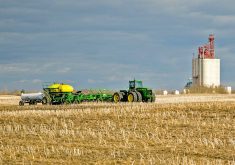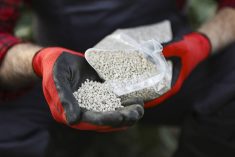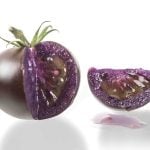Enhanced efficiency fertilizers (EEFs) have been available to growers for a number of years now, but are farmers rushing to use them in their fields?
The idea behind enhanced efficiency fertilizers to to maximize how much nutrient gets to the plant rather than being lost to the surrounding environment. The products control a slower release of nitrogen into the soil so they are more effectively taken up by plants.
It’s touted as a win-win for both farmers — lost nutrient means lost dollars, after all — and the environment, since a bigger percentage of nitrogen taken up by the plant means a lower percentage at risk of hitting the atmosphere at the greenhouse gas nitrous oxide.
Read Also

Manitoba boosts stake in cereals centre to $23.5 million
Premier Wab Kinew said the additional project funds will help ‘Trump-proof’ the provincial economy.
WHY IT MATTERS: Canadian farmers have been pushed more strongly in the last few years to adopt practices that reduce fertilizer greenhouse gas emissions, with a federal reduction goal looming by the end of the decade.
Lyle Cowell, a senior agronomist with Nutrien Wholesale, pointed to the economic benefit of the products to farmers. “One, you bought that fertilizer, you don’t want to lose the fertilizer. Plus, if you lose fertilizer from your farming system, that can mean you have a low yield,” he said.
Cowell also pointed to the environmental reasoning behind the products.
On the downside, EEFs can be more expensive than conventional fertilizers, and inviting farmers to move away from practices that have worked for them for years can be a hurdle.
As for what the future holds for EEFs, “time will tell,” added Cowell.
The products have commonly showed up in crop research plots as academics and industry try to home in on their best use.
Fall fertilizer advice
How well harvest season goes often determines how much of the fall fertilizer growers want to get down actually makes it into the field.
Doing it right protects a grower’s investment of time and money from nitrogen losses due to volatilization, leaching or denitrification.
If you opt to broadcast fertilizer in the fall, a dual inhibitor is the way to go, says Bryce Geisel, senior agronomist with Koch Agronomic Services.
SUPERU is one such option.
“It has both the urease inhibitor and denitrification,” said Geisel, “so we reduce all three forms of loss. So that’s a big step with those dual inhibitors with it.”
Fall anhydrous ammonia applications are common in Manitoba, he noted. In those cases, a nitrification inhibitor may be of benefit.
“Typically, what farmers have done in the past is they’ll wait until the soil cools down, and then they put that anhydrous ammonia in,” said Geisel.
“Fall is getting very compact. There’s a lot of operations that are happening. So one of the trends we are seeing is farmers and agronomists looking for nitrification inhibitors.”

As far as uptake among farmers for EEFs, it really depends on the individual farm.
“Obviously, there’s the environmental piece that people have talked about,” said Geisel, “but there’s also what we tend to see is a lot more (focus) on the operational efficiency piece where farmers are using it to spread out their fertilizer applications.”
“There’s a lot of different ways farmers are playing with it to help manage costs … they’re picking and choosing what kind of fits in their operation.”
















